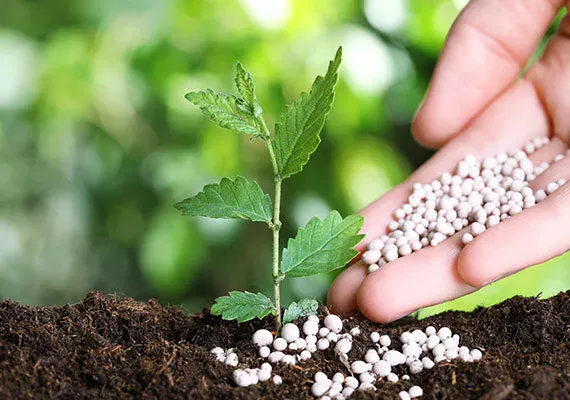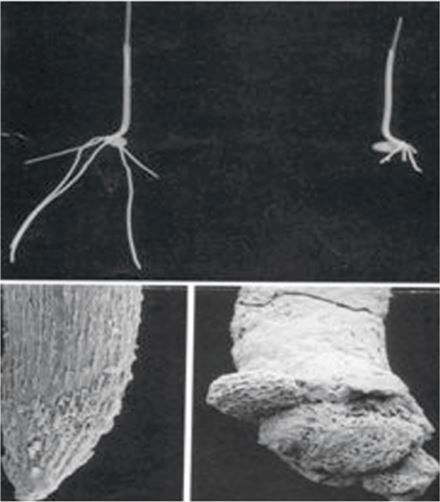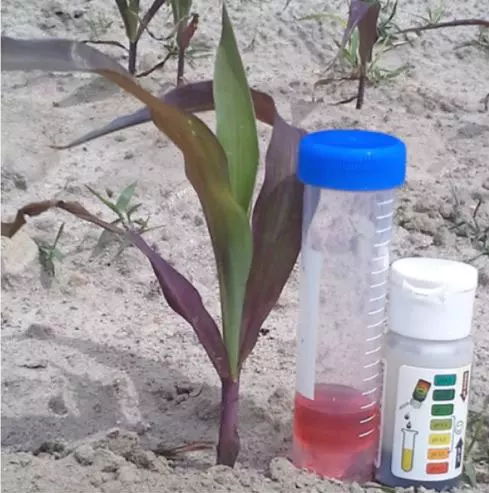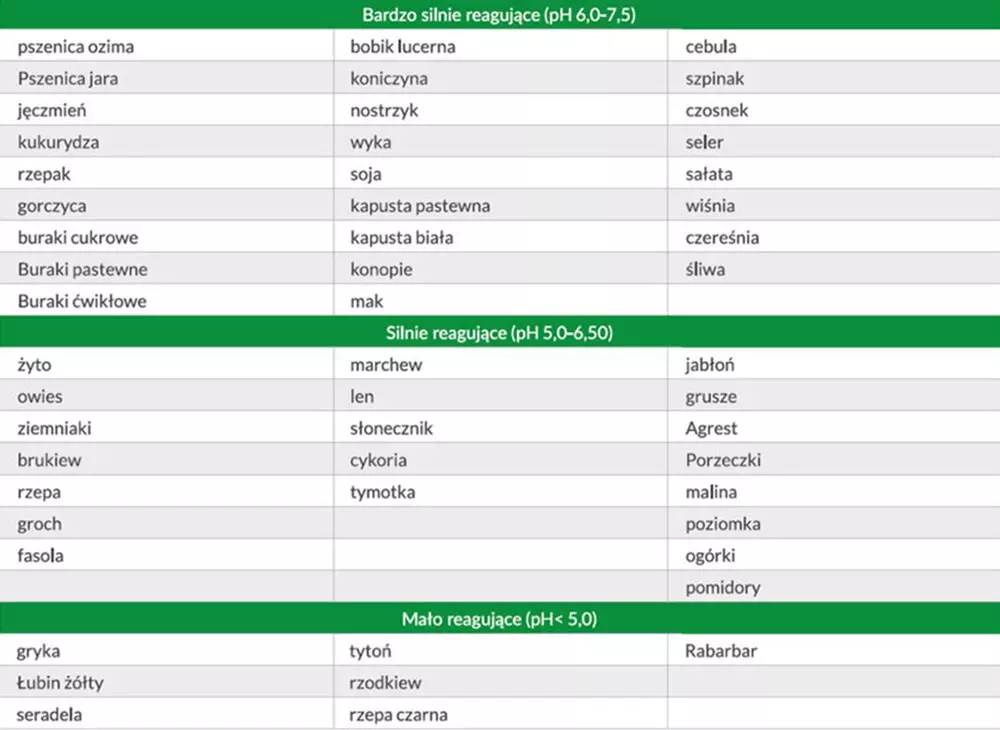
WHY DO SOILS IN POLAND REQUIRE LIMING?
Liming is an important agronomic practice contributing to the improvement of soil conditions, such as maintaining the granular structure of the soil, aeration, soil pH, and increasing the availability of nutrients, which significantly influences yield increases and the profitability of crop production. However, it should be remembered that lime is a highly reactive agent in the soil. Its application rate should be very precise regardless of the time of year the application is decided upon. This allows us to influence the yields of crops in the following year.
In soils with a pH KCl of 5.0 and lower, the mobility of aluminum ions increases, which causes poor development of the root system of plants by deforming root growth cones and causing root hair death (Fig. 1). Plants cannot then absorb water and dissolved mineral nutrients from the soil, resulting in the inhibition of plant growth, and even plant death. Phosphorus deficiency symptoms can be observed on the aboveground parts of plants growing on acidic and very acidic soils (Fig. 2). Crops such as barley, wheat, rapeseed, maize, and sugar beets are particularly sensitive to acidic soil pH (Tab. 1). However, these plants are also very sensitive to sudden changes in soil pH, so their liming should be done before planting.

Fig. 1. Inhibition of root growth and deformation of root growth cones of grain seedlings subjected to the toxic effect of aluminum (source: Delhizei Ryan,1995)

Fig. 2. Symptoms of phosphorus deficiency in maize growing on very acidic soil (Szulc 2017)

Fig. 1. Effect of soil pH on the efficiency (%) of nitrogen, phosphorus, and potassium utilization (source Hołubowicz-Kliza 2006

Tab. 1. Division of plants in terms of reaction to liming (source: Hołubowicz-Kliza 2006)
The most appropriate time to perform this agronomic practice on acidic soils is during the summer after harvesting rapeseed and cereals. The applied lime can then be thoroughly mixed with the soil. However, organizational and climatic conditions may prevent liming, for example, due to the short period between the harvest of the preceding crop and the sowing of the subsequent crop or lack of water in the soil. It is worth considering the possibility of carrying out this practice in the autumn-winter period. We will then use the autumn-winter water reserve, which will allow the applied lime to dissolve and change the soil pH, thereby contributing to increased efficiency in the use of mineral nutrients from fertilizers or accumulated in the soil (Fig. 1).
WINTER LIMING – WHAT FERTILIZER TO USE AND HOW TO APPLY IT?
If liming was not carried out in autumn, it is not worth waiting until spring – it is best to do this work in winter. In spring, due to thaws, the conditions will not be as favorable as when the soil is frozen. Liming in winter also allows for a safe time interval between the soil acidification treatment and the growth of new plants. The use of lime in the winter extends the time of its contact with the soil, and heavy spreading equipment does not overly compact the soil and destroy its structure. Moreover, it is much less risky than liming directly before sowing. Winter liming should be done using a specialized preparation. It is not recommended to use oxide lime at this time of year because it is highly hygroscopic, so it will clump on the soil surface in winter conditions. On the other hand, it is difficult to mix frozen soil with powdered lime.
What preparations should be used for winter liming? Carbonate lime is a better choice. It works much better and faster at lower temperatures. Frozen soil contains water, which naturally moves deeper into the soil profile. Carbonate lime will penetrate there with it. Remember that winter liming is much more beneficial than spring liming when the soil is already covered with vegetation. With the passage of time and approaching the start of plant germination, the effectiveness of liming decreases. On the other hand, if we refrain from liming acidic soils, the consequences will be irreversible, and the yield will be poor.
For soils sown with winter crops, granulated carbonate lime such as Polcalc III Generation or SuperMag is recommended, especially for use on acidic and magnesium-deficient soils. For fields not sown in the autumn period, dusty lime such as Kujawit or Radkowit should be applied at a rate of 1.5-3.5 tˑha-1. In the case of granule application, the dose is 500-1000 kgˑha-1.
WHEN LIMING CANNOT BE PERFORMED?
When applying lime in late autumn or winter, it is necessary to adhere to legal regulations that specify when a lime application can be performed in detail.
The most important legal acts regulating this issue include the Fertilizers and Fertilization Act of 2021 (Journal of Laws of 2021, item 76, as amended) and the Regulation of the Council of Ministers of 27 July 2018 regarding the „Program of actions aimed at reducing water pollution with nitrates from agricultural sources and preventing further pollution”. The law and the regulation contain a ban on the use of fertilizers on soils:
frozen – soils that are hardened, resist pressure, and do not absorb water due to the blocking of pores by ice (frozen soil is not soil that thaws at least superficially during the day);
flooded with water – soils where water puddles are visible;
saturated with water – soils that, despite the lack of puddles, do not absorb water, are mucky, and plastic;
covered with snow – fields where at least 50% of the surface is covered with a layer of snow, under which the soil is not visible.
Wapnowanie wykonane w okresie zimowym korzystniej wpływa na plon roślin, niż gdy zabieg ten przeprowadzany jest w okresie wiosennym. W czasie wiosny może wystąpić wiosenny niedobór wody, a to wpłynie na zmniejszenie szybkości rozpuszczania się granulowanych nawozów wapniowych i wapniowo-magnezowych.
WHAT ARE THE ADVANTAGES OF WINTER LIMING?
Liming performed in winter has a more beneficial effect on crop yields than when this treatment is carried out in spring. During spring, there may be a spring water deficit, which will reduce the rate of dissolution of granular lime fertilizers and lime-magnesium fertilizers.
One of the advantages worth mentioning is that winter liming is done in fairly favorable conditions. Apart from low temperatures, which are inconvenient for humans but advantageous for technical reasons, frozen soil allows for the movement of heavy spreading equipment across the field. In autumn and spring, such treatments entail local soil structure destruction. Frozen soil will not be trampled, and plants across the field will have equal chances during germination and the initial growth stage. Late autumn and winter liming are most beneficial for both soil and plants.
For detailed information regarding fertilizers produced by Polcalc Calcium Fertilizers Ltd., we encourage you to contact our distributors or to familiarize yourself with the information on our website: www.polcalc.pl.






